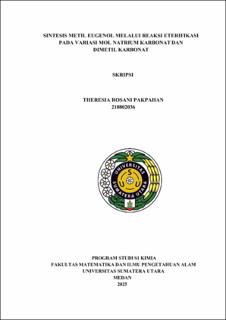Sintesis Metil Eugenol Melalui Reaksi Eterifikasi pada Variasi Mol Natrium Karbonat dan Dimetil Karbonat
Synthesis of Methyl Eugenol Through Etherification Reaction at Variation of Moles of Sodium Carbonate and Dimethyl Carbonate

Date
2025Author
Pakpahan, Theresia Rosani
Advisor(s)
Peranginangin, Sabarmin
Metadata
Show full item recordAbstract
The synthesis of methyl eugenol has been carried out through the etherification reaction of eugenol with dimethyl carbonate (DMC) using sodium carbonate (Na₂CO₃) as a basic agent and tetrabutylammonium bromide (TBAB) as a phase transfer catalyst. The reaction was carried out under reflux conditions for 5 hours at temperatures of ≥91°C, by varying the moles of Na₂CO₃ (0.3; 0.6; and 0.9 mol) and DMC (16, 18, and 20 mmol). The resulting product was characterized using FT-IR spectroscopy and GC-MS. Based on the results of %area analysis GC-MS obtained the most maximum methyl eugenol content for sodium carbonate mole variation is at 0.6 mmol sodium carbonate which is 62.06%. The maximum methyl eugenol content for dimethyl carbonate mole variation is at 18 mmol dimethyl carbonate which is 82.44%. The results of FT-IR analysis showed the disappearance of OH group absorption at wave numbers around 3200-3600 cm-1 and the appearance of C-O-C asymmetrical ether stretching vibrations from methoxy groups (OCH3) at wave numbers 1140.6 cm-1 which indicates the success of the etherification reaction and the formation of methyl eugenol. So it can be concluded that there has been a substitution process of the -CH3 group to the H atom of the -OH group of eugenol.
Collections
- Undergraduate Theses [1420]
